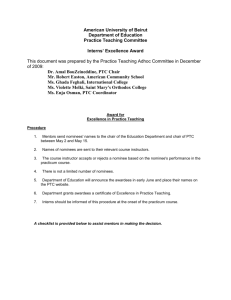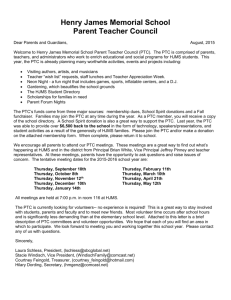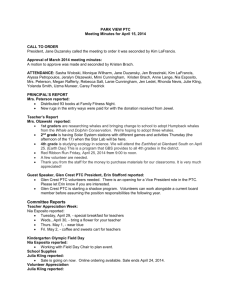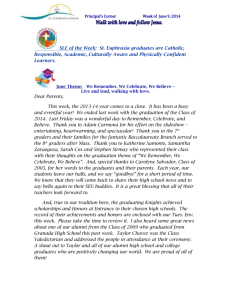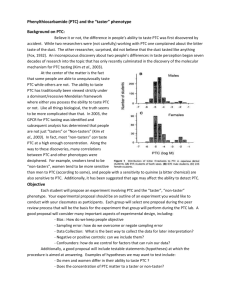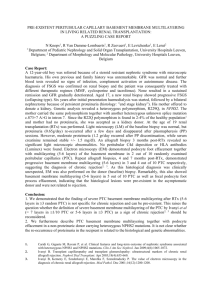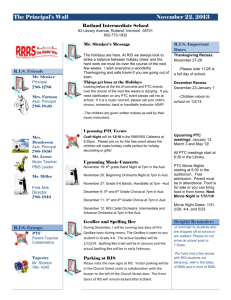2AC AT: Onshore Wind CP
advertisement
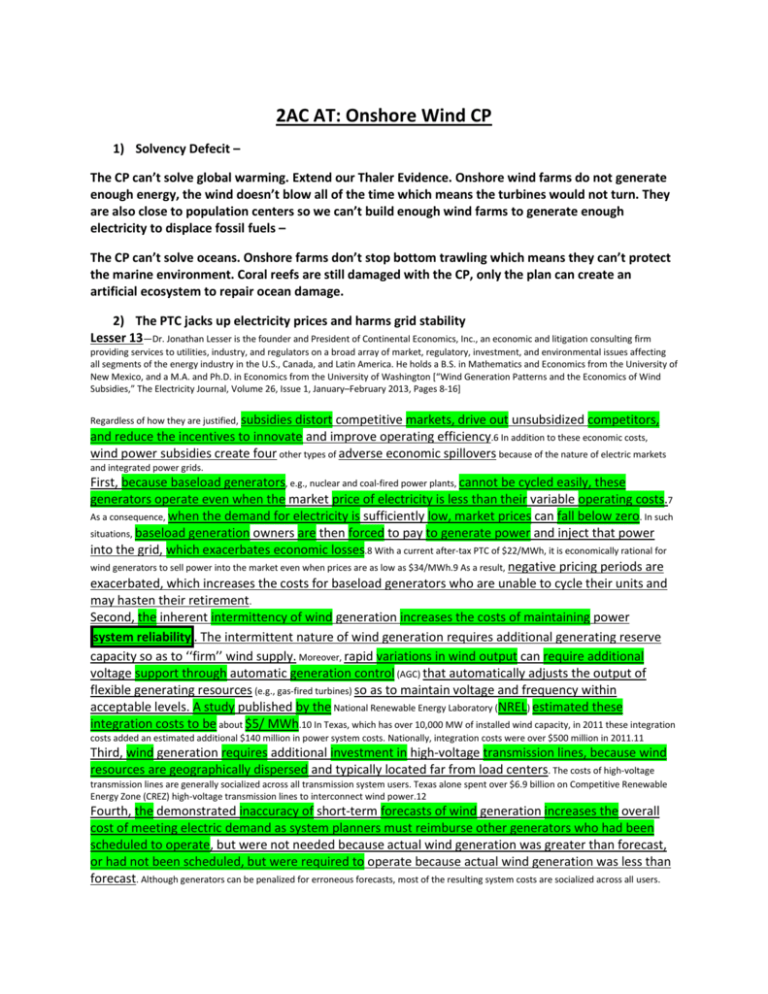
2AC AT: Onshore Wind CP 1) Solvency Defecit – The CP can’t solve global warming. Extend our Thaler Evidence. Onshore wind farms do not generate enough energy, the wind doesn’t blow all of the time which means the turbines would not turn. They are also close to population centers so we can’t build enough wind farms to generate enough electricity to displace fossil fuels – The CP can’t solve oceans. Onshore farms don’t stop bottom trawling which means they can’t protect the marine environment. Coral reefs are still damaged with the CP, only the plan can create an artificial ecosystem to repair ocean damage. 2) The PTC jacks up electricity prices and harms grid stability Lesser 13—Dr. Jonathan Lesser is the founder and President of Continental Economics, Inc., an economic and litigation consulting firm providing services to utilities, industry, and regulators on a broad array of market, regulatory, investment, and environmental issues affecting all segments of the energy industry in the U.S., Canada, and Latin America. He holds a B.S. in Mathematics and Economics from the University of New Mexico, and a M.A. and Ph.D. in Economics from the University of Washington [“Wind Generation Patterns and the Economics of Wind Subsidies,” The Electricity Journal, Volume 26, Issue 1, January–February 2013, Pages 8-16] Regardless of how they are justified, subsidies distort competitive markets, drive out unsubsidized competitors, and reduce the incentives to innovate and improve operating efficiency.6 In addition to these economic costs, wind power subsidies create four other types of adverse economic spillovers because of the nature of electric markets and integrated power grids. First, because baseload generators, e.g., nuclear and coal-fired power plants, cannot be cycled easily, these generators operate even when the market price of electricity is less than their variable operating costs.7 As a consequence, when the demand for electricity is sufficiently low, market prices can fall below zero. In such situations, baseload generation owners are then forced to pay to generate power and inject that power into the grid, which exacerbates economic losses.8 With a current after-tax PTC of $22/MWh, it is economically rational for wind generators to sell power into the market even when prices are as low as $34/MWh.9 As a result, negative pricing periods are exacerbated, which increases the costs for baseload generators who are unable to cycle their units and may hasten their retirement. Second, the inherent intermittency of wind generation increases the costs of maintaining power system reliability . The intermittent nature of wind generation requires additional generating reserve capacity so as to ‘‘firm’’ wind supply. Moreover, rapid variations in wind output can require additional voltage support through automatic generation control (AGC) that automatically adjusts the output of flexible generating resources (e.g., gas-fired turbines) so as to maintain voltage and frequency within acceptable levels. A study published by the National Renewable Energy Laboratory (NREL) estimated these integration costs to be about $5/ MWh.10 In Texas, which has over 10,000 MW of installed wind capacity, in 2011 these integration costs added an estimated additional $140 million in power system costs. Nationally, integration costs were over $500 million in 2011.11 Third, wind generation requires additional investment in high-voltage transmission lines, because wind resources are geographically dispersed and typically located far from load centers. The costs of high-voltage transmission lines are generally socialized across all transmission system users. Texas alone spent over $6.9 billion on Competitive Renewable Energy Zone (CREZ) high-voltage transmission lines to interconnect wind power.12 Fourth, the demonstrated inaccuracy of short-term forecasts of wind generation increases the overall cost of meeting electric demand as system planners must reimburse other generators who had been scheduled to operate, but were not needed because actual wind generation was greater than forecast, or had not been scheduled, but were required to operate because actual wind generation was less than forecast. Although generators can be penalized for erroneous forecasts, most of the resulting system costs are socialized across all users. Despite claims by wind power advocates that wind generation can be predicted accurately several days in advance, allowing system operators to reduce, if not eliminate, the impacts of wind’s volatility, actual data does not bear this out.13 3) Permutation: Do both 4) The PTC creates huge market distortions and negative pricing—creates inefficient power generation Zycher 12—Benjamin Zycher, Ph.D. in economics from the University of California Los Angeles, is the president of Benjamin Zycher Economics Associates, Inc., a senior fellow at the Pacific Research Institute, and a visiting scholar at the American Enterprise Institute. He is also an associate in the Intelligence Community Associates program of the Office of Economic Analysis, Bureau of Intelligence and Research, U.S. Department of State [December 17, 2012, “Let the Wind Power PTC Expire,” http://energy.nationaljournal.com/2012/12/should-congresssupport-wind-t.php#2275746] Simple clarity is a commodity both valuable and rare inside the Beltway, but Senator Lamar Alexander provides a healthy dose of it in his introductory observations on the proposed extension of the production tax credit (PTC) for wind power. Particularly useful is his point about the large market distortions created by the PTC, which yield electricity far more costly than necessary and longer-term investment in a mix of generating units far less efficient than possible. The PTC already has been extended six times. Since its creation, the cost of the PTC to taxpayers has increased consistently; even a single year extension will cost U.S. taxpayers more than $12 billion according to the Congressional Joint Committee on Taxation. Despite repeated promises that just one more extension will make wind power competitive with conventional electricity, the opposite is the reality: Until all forms of power production are allowed to compete on an equal basis, the PTC creates powerful incentives for wind producers to underprice their electricity . Indeed, because of the PTC ($22 per megawatthour), they often find it profitable to charge negative prices by paying system operators to take their power, particularly when demand is relatively low at night and in the winter. In the short run, this underpricing phenomenon means that conventional generating facilities---coal, gas, and nuclear--- cannot be operated efficiently because they must be cycled up and down , and also must underprice their outputs when engineering constraints make such cycling difficult or dangerous. “Underpricing” may sound great for consumers, but, sadly, there are no free lunches. Operating costs for the conventional generators must rise with less efficient operation, and consumers must pay them. Wind power requires substantial backup capacity in order to prevent brownouts and blackouts---the winds often refuse to cooperate with the demands of consumers---and that backup insurance does not come cheap, a factor made worse by the PTC. Transmission costs are higher for wind power, and the PTC exacerbates that effect by distorting generation investment toward wind farms. Again: Consumers must pay these costs, whether directly or indirectly; they are real but hidden by the PTC. In the longer run, the PTC reduces expected returns for conventional power and increases them for wind farms, thus distorting investment in the electric power sector. The result is a mix of generating capacity more costly and less reliable than otherwise would be the case , and an artificial barrier for efficient technological advance. In addition, the PTC allows individual states to shift part of their bills for wind power onto federal taxpayers, thus increasing the adoption of state policies subsidizing wind investment. This means that the narrow budget cost of the PTC, while itself not small, understates the larger economic cost of the PTC. Renewable portfolio standards---guaranteed market shares---are a prominent example of this effect. Over time, regional economies and the U.S. economy in the aggregate will be burdened increasingly with a power generation mix substantially less efficient than otherwise would be the case. 5) Conditionaltiy is a voting issue. Fainress – Time Skew – being able to kick the CP at any time means that the 2AC answers on the page get wasted. This is unfair for debate because the neg can wish away Education – Strategy Skew – Conditionality causes shallow debating because they neg never has to debate arguments if they think they’re good. This means the quality of debate is worse because it makes debates late breaking and the neg is allowed to avoid in-depth discussion. 6) OSW decreases hurricane magnitude – best studies confirm JACOBSON, ARCHER, & KEMPTON 14 a. Department of Civil and Environmental Engineering, Stanford University b & c. all three are College of Earth, Ocean, and Environment, University of Delaware [Mark Z. Jacobson, Cristina L. Archer, & Willett Kempton, Taming hurricanes with arrays of offshore wind turbines, Nature Climate Change 4, 195–200 (2014) doi:10.1038/nclimate2120 Hurricanes are causing increasing damage to many coastal regions worldwide1, 2. Offshore wind turbines can provide substantial clean electricity year-round, but can they also mitigate hurricane damage while avoiding damage to themselves? This study uses an advanced climate–weather computer model that correctly treats the energy extraction of wind turbines3, 4 to examine this question. It finds that large turbine arrays (300+ GW installed capacity) may diminish peak near-surface hurricane wind speeds by 25–41 m s−1 (56– 92 mph) and storm surge by 6–79%. Benefits occur whether turbine arrays are placed immediately upstream of a city or along an expanse of coastline. The reduction in wind speed due to large arrays increases the probability of survival of even present turbine designs. The net cost of turbine arrays (capital plus operation cost less cost reduction from electricity generation and from health, climate, and hurricane damage avoidance) is estimated to be less than today’s fossil fuel electricity generation net cost in these regions and less than the net cost of sea walls used solely to avoid storm surge damage. Controlling disasters key to save millions of lives SID-AHMED 05 Managing Editor for Al-Ahali [Mohamed Sid-Ahmed, “The post-earthquake world”, Issue #724, http://weekly.ahram.org.eg/2005/724/op3.htm] The year 2005 began with a calamity, resulting not from conflicts between people but from an unprecedented natural disaster that has so far claimed over 155,000 lives, a figure that is expected to rise still more over the coming period. Is this Nature's reaction to the abuse it is suffering at the hands of the human race, its revenge on us for challenging its laws beyond acceptable limits? The earthquake that struck deep under the Indian Ocean was the strongest in over a century. What is still more critical is that what we have witnessed so far is only the beginning of the catastrophe. According to a spokesman from the World Health organisation, "there is certainly a chance that we could have as many dying from communicable diseases as from the tsunamis". The logistics of providing the survivors with clean water, vaccines and medicines are formidable, and, with many thousands of bodies lying unburied, epidemics spread by waterborne diseases are expected to claim many thousands of victims. There is also the possibility of seismic activity elsewhere in the world because disturbances in the inner structure of the earth's crust have occurred and there are no means to foresee how they will unfold. Will they build up into still broader disarray and eventually move our planet out of its orbit around the sun? Moreover, even if we can avoid the worse possible scenario, how can we contain the earthquake's effects ecologically, meteorologically, economically and socially? The contradiction between Man and Nature has reached unprecedented heights, forcing us to reexamine our understanding of the existing world system. US President George W Bush has announced the creation of an international alliance between the US, Japan, India, Australia and any other nation wishing to join that will work to help the stricken region overcome the huge problems it is facing in the wake of the tsunamis. Actually, the implications of the disaster are not only regional but global, not to say cosmic. Is it possible to mobilise all the inhabitants of our planet to the extent and at the speed necessary to avert similar disasters in future? How to engender the required state of emergency, that is, a different type of inter-human relations which rise to the level of the challenge before contradictions between the various sections of the world community make that collective effort unrealisable? The human species has never been exposed to a natural upheaval of this magnitude within living memory. What happened in South Asia is the ecological equivalent of 9/11. Ecological problems like global warming and climatic disturbances in general threaten to make our natural habitat unfit for human life. The extinction of the species has become a very real possibility , whether by our own hand or as a result of natural disasters of a much greater magnitude than the Indian Ocean earthquake and the killer waves it spawned. Human civilisation has developed in the hope that Man will be able to reach welfare and prosperity on earth for everybody. But now things seem to be moving in the opposite direction, exposing planet Earth to the end of its role as a nurturing place for human life. Today, human conflicts have become less of a threat than the confrontation between Man and Nature. At least they are less likely to bring about the end of the human species. The reactions of Nature as a result of its exposure to the onslaughts of human societies have become more important in determining the fate of the human species than any harm it can inflict on itself. Until recently, the threat Nature represented was perceived as likely to arise only in the long run, related for instance to how global warming would affect life on our planet. Such a threat could take decades, even centuries, to reach a critical level. This perception has changed following the devastating earthquake and tsunamis that hit the coastal regions of South Asia and, less violently, of East Africa, on 26 December. This cataclysmic event has underscored the vulnerability of our world before the wrath of Nature and shaken the sanguine belief that the end of the world is a long way away. Gone are the days when we could comfort ourselves with the notion that the extinction of the human race will not occur before a long-term future that will only materialise after millions of years and not affect us directly in any way. We are now forced to live with the possibility of an imminent demise of humankind.
